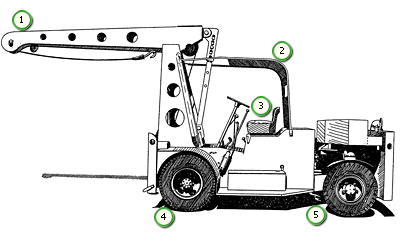
Date of Issue: April 12, 2006
Incident Summary:
A mobile crane was being used to lift a large truck. The crane was set up beside the truck, rather than being head on. When the trailer was lifted, the crane tipped over and threw the operator between the crane and truck, resulting in the death of the operator.

Legend:
- Side loading, may contribute to tipping
- Falling Objects Protection, may collapse in a rollover
- No seat belt contributes to injury in rollover
- Operate only with all tires installed
- Narrow rear axle may contribute to tipping
Hazard Summary:
The hazards from this type of operation include the following:
- The crane had no seat belt. A seatbelt would have kept the operator in the cab, thus minimizing injury.
- The crane - which had a fixed angle boom extending out from the body of the crane - was designed to lift head on. The crane was used to lift a load that was off to the side, defeating the couterweights and allowing the high centre of gravity to pull the crane sideways and tip it over.
- The crane was missing a front wheel on the side where the load was being applied. Had the wheel been in place the tip-over might have been prevented.
- The crane was being used on uneven ground, which may have resulted in a less stable base than expected. A less stable base can contribute to a tip.
- Like many older yard cranes this one had a narrow rear axle, making for a triangular base. The triangular base would have made the crane more vulnerable to a side load than a crane with a rectangular base.
Preventive Measures:
The above hazards could have been minimized if the following precautions had been used:
- Seat belts save lives. Employers should consider installing them in all vehicles.
- By lifting the load from the side the operator was using the crane in a way it was not designed for. Operators should ensure they operate cranes in accordance with their design, any owner's manuals or manufacturer's specifications and the relevant standards.
- The crane should not have been operated when it was missing a wheel. Again, this is using a crane in a way for which it was not designed. Operators should ensure they operate cranes in accordance with their design, any owner's manuals or manufacturer's specifications and the relevant standards.
- Operators should ensure that the crane is used on even ground with a stable base. Using it otherwise may go against the manufacturer's specifications.
- Operators must be aware that triangular wheel-based vehicles may be likely to tip over; extra care must be taken to minimize side loading and load swing.
- Falling Object Protective structures (FOPs) may present a crushing hazard in a rollover.
Standards:
The following standards are relevant to yard crane operations:
- Occupational Safety General Regulations - Part 7 - Hoists and Mobile Equipment
- Canadian Standards Association standard Z150-1998, “Safety Code for Mobile Cranes”.